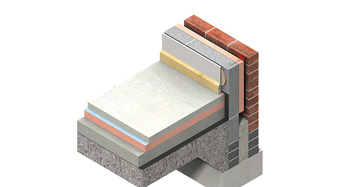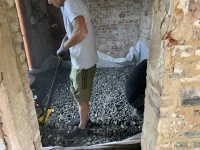I'm the proud new owner of a Grade II Listed building with a mountain of damp issues. We have a very lengthy remediation plan including exterior masonry paint removal, french drains, re-plastering with lime plaster etc etc.
We have a concrete slab in the kitchen which needs replacing because the levels are all over the place (and it's a recent addition) so my natural instinct was to go down the breathable route and use limecrete. Reading forums it seems to be the Marmite of building materials so I was hoping science would give me a helping hand but reading on Historic England's website they state:
"Proposals often include the replacement of an existing floor with some form of insulated concrete or ‘limecrete’ ground bearing slab. It is a widely-held belief that if an impermeable ground bearing slab is installed in an old building, ground moisture will be ‘driven’ up adjacent walls. Although there are numerous references to this phenomenon, both in technical and product literature, they tend to be anecdotal and unsupported by scientific evidence"
They also point to some research being done by Bath university here:
limecrete-vs-concrete-study
Which concludes "Preliminary results obtained from modelling and laboratory tests suggest that NHL5-based limecrete was marginally more effective than a concrete slab in transferring moisture."
Considering it is not just marginally more expensive, harder to find those with the skills to use it, much longer in drying times and weaker than concrete is there any real point in terms of benefit to the building itself?
I honestly really want to be convinced that it's the way to go but other than people who have had it installed and have dry rooms which could have also been made dry with use of concrete I find no real evidence....
We have a concrete slab in the kitchen which needs replacing because the levels are all over the place (and it's a recent addition) so my natural instinct was to go down the breathable route and use limecrete. Reading forums it seems to be the Marmite of building materials so I was hoping science would give me a helping hand but reading on Historic England's website they state:
"Proposals often include the replacement of an existing floor with some form of insulated concrete or ‘limecrete’ ground bearing slab. It is a widely-held belief that if an impermeable ground bearing slab is installed in an old building, ground moisture will be ‘driven’ up adjacent walls. Although there are numerous references to this phenomenon, both in technical and product literature, they tend to be anecdotal and unsupported by scientific evidence"
They also point to some research being done by Bath university here:
limecrete-vs-concrete-study
Which concludes "Preliminary results obtained from modelling and laboratory tests suggest that NHL5-based limecrete was marginally more effective than a concrete slab in transferring moisture."
Considering it is not just marginally more expensive, harder to find those with the skills to use it, much longer in drying times and weaker than concrete is there any real point in terms of benefit to the building itself?
I honestly really want to be convinced that it's the way to go but other than people who have had it installed and have dry rooms which could have also been made dry with use of concrete I find no real evidence....








